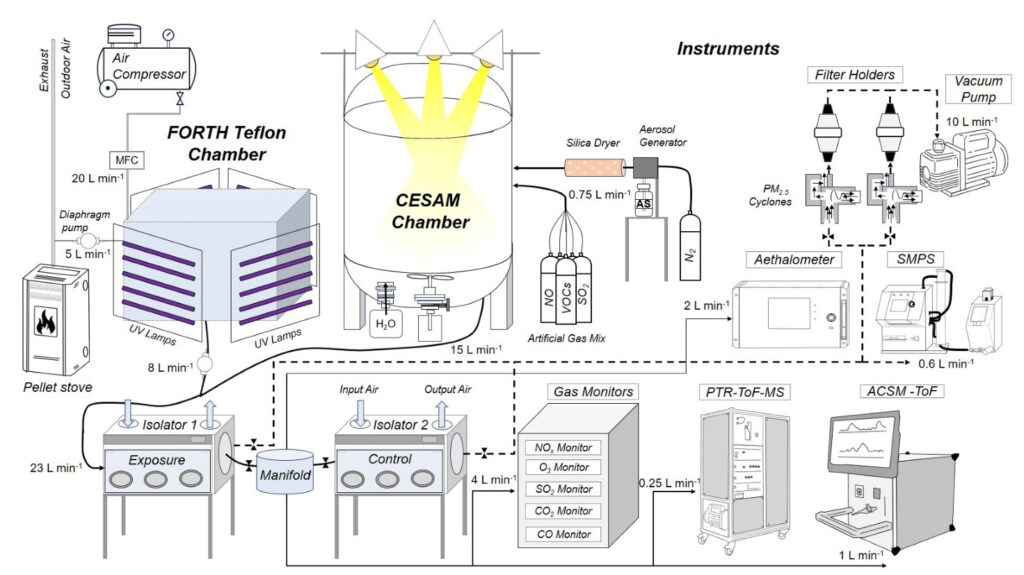A VERSATILE ATMOSPHERIC SIMULATION CHAMBER
A versatile atmospheric simulation chamber targeting specific complex exposomes
The health impacts of the external exposome identified in the other parts of REMEDIA are identified and quantified in naïve, COPD or CF preclinical models.
Our strategy is to couple an atmospheric simulation chamber, where the complexity of real atmosphere is reproduced, to cabinets where preclinical models are exposed.
Atmospheric simulation chambers are valuable tools for studying the impact of different air pollutants and sources on preclinical models. REMEDIA developed a novel experimental approach for the generation of realistic polluted atmospheres, by coupling, for the first time, two advanced chambers, the CESAM (Chamber for Experimental Multiphase Atmospheric Simulation) chamber and the FORTH (Foundation for Research & Technology – Hellas) mobile simulation chamber to continuously generate air pollution levels that represent a variety of urban atmospheric conditions. The chambers can also be used on their own, but their combination facilitates the production of stable and representative aerosols, allowing for long-term exposure studies on preclinical models under controlled conditions focusing on specific sources (e.g., biomass burning). The figure below depicts a schematic view of the experimental platform’s setup, which integrates the CESAM and mobile FORTH chambers, incorporating the primary emission source. This integration allows for the simulation of diverse urban atmospheres influenced by biomass burning emissions. The setup features two commercial whole-body exposure devices, identified as “exposure” and “control” isolators, respectively, designed to house preclinical models (mice). Additionally, it includes a suite of state-of-the-art instrumentation for characterizing and monitoring the produced aerosol and gas-phase pollutants. Details can be found in Georgopoulou et al., 2024.

Schematic view of the platform combining the CESAM and FORTH chambers, “feeding” the exposure device where the exposed preclinical models are hosted. The reference preclinical models in the control exposure chamber are exposed to a reference atmosphere (clean air in this case). Also shown the instrumentation used for the characterization of the simulated atmosphere.

View of the Pollurisk Platform
Scientific articles:
- A coupled atmospheric simulation chamber system for the production of realistic aerosols and preclinical model exposure
- Secondary aerosol formation during the dark oxidation of residential biomass burning emissions
- Evaluation of high-resolution predictions of fine particulate matter and its composition in an urban area using PMCAMx-v2.0 Geosci
- Acute exposure to realistic simulated urban atmospheres exacerbates pulmonary phenotype in cystic fibrosis-like mice.
- High-Resolution Downscaling of Source Resolved PM2.5 Predictions Using Machine Learning Models
- Characterization and dark oxidation of the emissions of a pellet stove
PhD thesis (in French):
- Impacts de la pollution atmosphérique sur le phénotype pulmonaire de la mucoviscidose : étude expérimentale sur deux modèles précliniques (M. Blayac).
Lien : https://theses.fr/2022PA120045
Summary : Cystic Fibrosis (CF) is a genetic disease due to a mutation of the CFTR gene encoding for an epithelial chloride channel. The disease is characterized by a progressive loss of respiratory function responsible for most of the morbidity and mortality of the disease. CF patients show an important genotypic variability along with a great phenotypic diversity between patients with the same mutations. This suggests the implication of other factors, either genetic or environmental. Among these factors, one that is of interest is air pollution, indeed representing the most important environmental risk for health. The objective of this thesis was to study, using an experimental approach, the effects of air pollution on CF pulmonary phenotype in two dedicated murine models. I used CESAM atmospheric simulation chamber to simulate at the laboratory multiphasic realistic atmospheres. This chamber is coupled to mice isolators allowing to expose living organisms to the simulated atmospheres. We simulated different types of urban atmospheres, with different levels of air pollutants, representative of Paris and Beijing atmospheres in summer and winter conditions. Mice were exposed to these atmospheres for 18H and 72H. Biological effects were then characterized by studying lung structure and function, mucus production as well as inflammatory and oxidative response. Exposure to urban atmospheres tended to stimulate mucus secretion and increased inflammatory biomarkers, oxidative stress, and expression of pulmonary proteinases. The effects were more important in CF mice compared to healthy mice and the type of response induced depended on the chemical composition of the considered atmosphere. Based on these effects, air pollution is highly suspected to contribute to CF physiopathology by increasing the severity of the disease.
- Effets de la pollution atmosphérique sur la santé : développement de protocoles innovants de simulation d’atmosphères urbaines et d’exposition de modèles précliniques (E. Al Marj).
lien : https://theses.fr/2023UNIP7034
Summary : The World Health Organization estimates that exposure to atmospheric pollution causes more than 4 million premature deaths annually worldwide. Atmospheric pollution is therefore a major health risk. However, the assessment of the health effects of atmospheric pollution has shortcomings. Indeed, epidemiological and experimental studies only take into account regulated atmospheric pollutants without considering the synergy that may exist between them, whereas atmospheric pollution is a multiphasic mixture of gaseous and particulate compounds interacting with each other and with environmental parameters. Moreover, the concentrations studied are rarely within realistic ranges. The objective of this work is to implement an innovative platform to study the effects of atmospheric pollution on health. To do this, mice were exposed to atmospheric situations representative of real atmospheres and episodes of urban air pollution, simulated in the laboratory. These simulated atmospheres were then qualified. We have thus succeeded in reproducing multiphasic urban atmospheres, by simulating their gaseous and particulate phases in the laboratory. The formation of secondary organic aerosols and functionalized volatile organic compounds confirm the quality of our simulations (proxy of real urban atmospheres), by highlighting the oxidation of organic matter. The results of the biological analyses on the exposed mice have highlighted the relevance of the platform for studying the effects of atmospheric pollution on health.
- Impact des expositions précoces à la pollution atmosphérique sur la maturation pulmonaire et la susceptibilité à développer une BPCO : une étude expérimentale (C. Buissot).
Lien : https://theses.fr/s305570
Summary : Chronic Obstructive Pulmonary Disease (COPD) is an adult disease characterized by a decline of the respiratory function. It results from gene-environment interactions occurring over the lifetime of the individual, which can alter normal lung development and thus be associated with changes in lung function trajectory. The importance of the exact window of exposure in the susceptibility to develop COPD at a later age is not known yet. We therefore aimed to explore the role of air pollution and seasonality (as environmental factors) during two stages of lung maturation on the susceptibility to develop COPD at adult age. Realistic atmospheres representative of Paris or Beijing in Summer or Winter conditions have been simulated thanks to the PolluRisk platform. Mice were exposed during two stages of lung maturation (early and late alveolarization). The impact of such exposures was evaluated on lung maturation, as well as on emphysema development after cigarette smoke exposure at adult age. Overall, our results show that early exposures, particularly to Paris Winter-like atmospheres, significantly impact lung maturation and respiratory function. This is not observed after an early exposure to Paris summer-like atmosphere. After cigarette smoke exposure, these mice also seem more impacted even though these results still need to be confirmed. Our results suggest that environmental exposures during early periods of lung development represent more susceptible windows to impact lung function and subsequent susceptibility to develop COPD. Our results illustrate the need for exposomic approaches to have a better understanding of early life risk factors of COPD.
- Contribution des expériences de simulation atmosphérique en laboratoire aux études en recherche biomédicale : génération d’analogues d’aérosols urbains issus de la combustion de biomasse, et évaluation de leur représentativité (J.C. Macias Rodriguez, to come).
Summary : In this thesis, the PolluRisk platform was enhanced with a protocol designed to replicate biomass combustion sources, allowing the creation of realistic atmospheres enriched with organic aerosol analogs. By coupling two simulation chambers or employing a tubular furnace, aerosols were produced with chemical compositions closely matching ambient air conditions, exemplified by a pollution event in Paris influenced by forest fires in Gironde during summer 2022. Detailed mass spectrometry analysis combined with cosine similarity quantified this resemblance, confirming the protocol’s validity for future biomass aerosol research. Combustion temperature emerged as a key parameter influencing aerosol chemical composition and oxidation. Experiments at 600°C generated more oxidized aerosols, whereas those at 400°C produced particles resembling freshly emitted aerosols characterized by high levels of fragment f60, a marker of biomass burning organic aerosol (BBOA). Improved experimental conditions also enabled the study of aerosol stability and chemical evolution, strengthening PolluRisk’s capacity to simulate complex atmospheres. Finally, to evaluate potential biomedical applications, mouse models were exposed to these aerosol analogs, suggesting that the chemical composition, particularly the oxidation state, could significantly affect respiratory health responses.
Public deliverables:
Link to get access to the platform:
Waiting for the PolluRisk platform services to be integrated in a European Research Infrastructure (with Trans National Access), please contact Patrice Coll (pcoll@lisa.ipsl.fr) and Sophie Lanone (sophie.lanone@inserm.fr).


